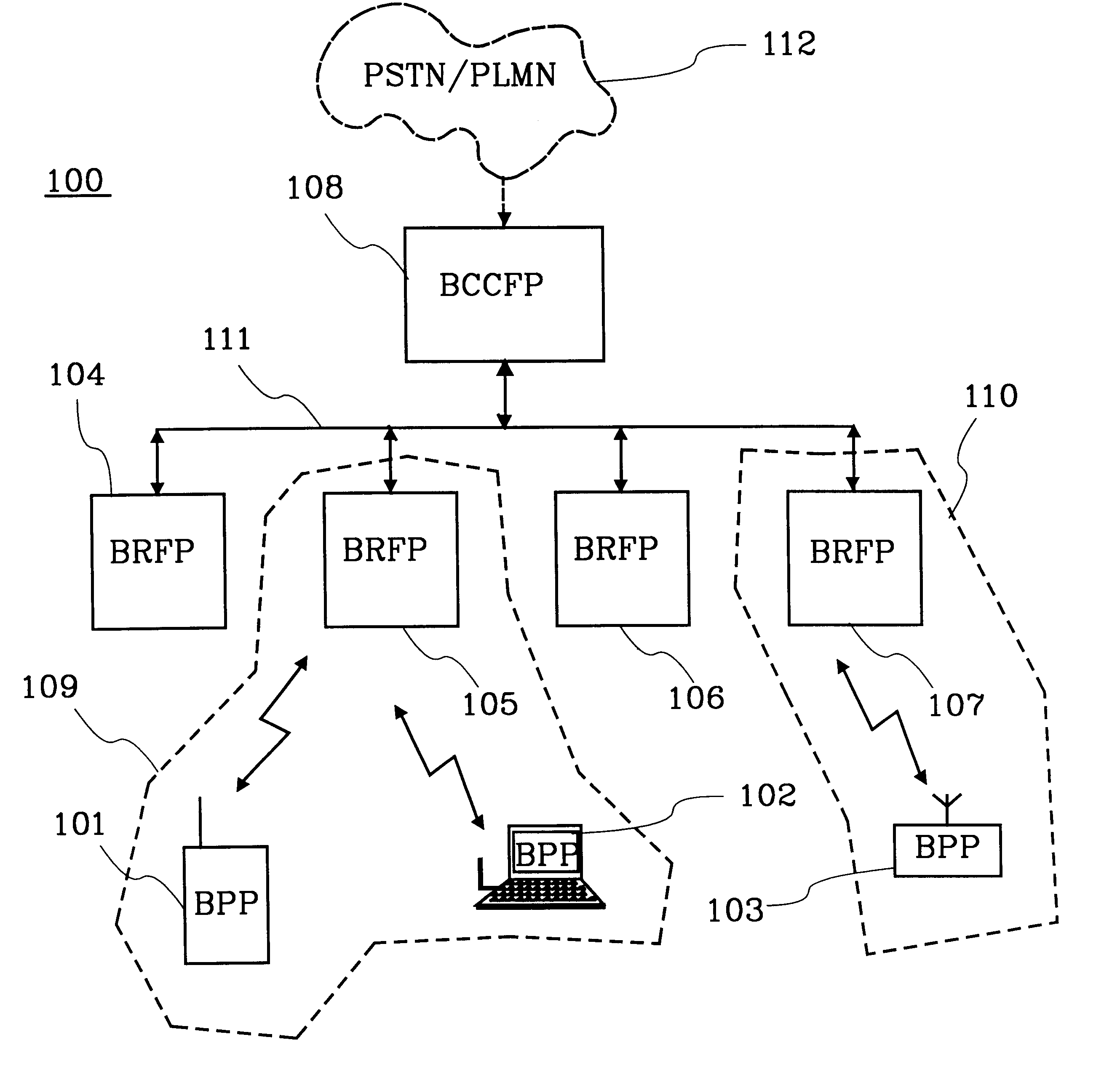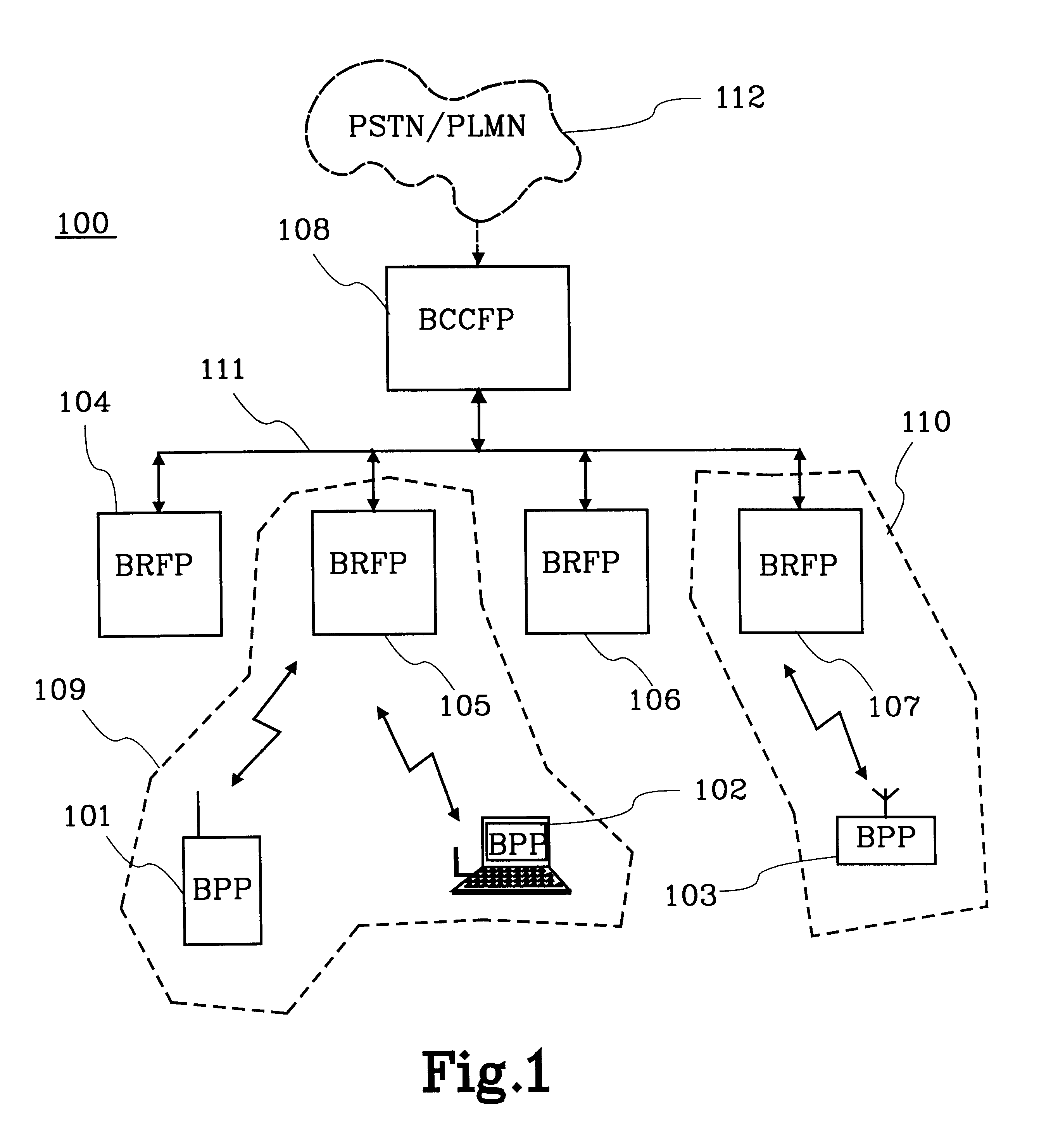Communication system
- Summary
- Abstract
- Description
- Claims
- Application Information
AI Technical Summary
Benefits of technology
Problems solved by technology
Method used
Image
Examples
first embodiment
FIG. 1 illustrates a block diagram of a cellular radio communication system 100 for utilising the present invention. The system 100 comprises a control-node (BCCFP) 108 connected to four radio-nodes (BRFP) 104-107 respectively. The BRFP 105 is serving two radio units (BPP) 101, 102 respectively and the BRFP 107 is serving a radio unit (BPP) 103. The BRFP 105 and the two BPPs 101, 102 respectively utilises a radio interface, to enable communication between them, and forms a first piconet 109 (a first local radio network). The BRFP 107 and the BPP 103 utilises the same radio interface and forms a second piconet 110 (a second local radio network). The radio interface used in piconet 109 is not synchronised with the radio interface used in piconet 110.
The control-node 108 may be connected to a PSTN (Public Switched Telephone Network) and / or a PLMN (Public Land Mobile Network) as illustrated by the dashed cloud 112. The control-node 108 can also be connected to other control-nodes so as ...
second embodiment
FIG. 6 illustrates a flow chart of the second method where the measurements in step 304 and 305 are made during an ongoing call. This means that step 304 and 305 according to FIG. 3 may be replaced by the following steps.
According to a step 601, the BRFP 105 transmits information to the BCCFP 108 regarding the exact clock information and hop sequence used for the call / link to the BPP 101.
According to a step 602, the BCCFP 108 forwards the information received in step 601 to the BRFP 104 and 106, i.e. to all additional BRFPs on the neighbouring list for BRFP 105.
According to a step 603, the BRFP 104 and 106 measures the signal strength and / or signal quality on the ongoing call between the BRFP 105 and the BPP 101, e.g. in a separate receiver in the BRFPs dedicated for monitoring (e.g. measuring).
According to a step 604, the BRFP 104 and 106 transmits the measured signal strength and / or signal quality to the BCCFP 108 which stores these measurements in the BRFP_candidates list for the...
third embodiment
The steps 601-604 may in the second method (not illustrated) be used as a complement to step 304 and 305 instead of replacing them. This means that steps 601-604 are performed after step 607 in FIG. 3.
If the link between the BPP 101 and the BRFP 105 becomes bad the second method may continue to perform roaming as described below (not illustrated in any flow charts).
The link roams from BRFP 105 to BRFP 104 that, according to the BRFP_candidates list for BRFP 105, has the best signal strength and / or signal quality for the moment (see FIG. 4). This means that the BCCFP 108 selects the new BRFP for roaming with the help of the BRFP_candidates list. This selection may as an alternative or as a complement be made on free capacity in the neighbouring BRFPs.
If the BPP 101 does not respond to any signalling from the BRFP 104, e.g. a page signal, the second method may end by unregister the BPP 101 as described below (not illustrated in any flow chart).
The BRFP 104 transmits an unregistered me...
PUM
 Login to View More
Login to View More Abstract
Description
Claims
Application Information
 Login to View More
Login to View More - R&D
- Intellectual Property
- Life Sciences
- Materials
- Tech Scout
- Unparalleled Data Quality
- Higher Quality Content
- 60% Fewer Hallucinations
Browse by: Latest US Patents, China's latest patents, Technical Efficacy Thesaurus, Application Domain, Technology Topic, Popular Technical Reports.
© 2025 PatSnap. All rights reserved.Legal|Privacy policy|Modern Slavery Act Transparency Statement|Sitemap|About US| Contact US: help@patsnap.com



